
The Importance of Choosing the Right Needle or Syringe: Ensuring Safe and Effective Use
When it comes to medical treatments, fitness enhancements, or even everyday tasks like administering vaccines, the needle and syringe are among the most important tools in the process. Whether you're a healthcare professional, a patient, or an athlete, choosing the right needle and syringe is essential to ensure that the process is safe, effective, and as painless as possible. In this blog, we’ll dive into why selecting the correct needle and syringe is so important and how it can affect your overall health and well-being.
1. Accuracy in Medication Delivery
One of the most critical reasons for choosing the right needle and syringe is ensuring that the medication or substance is delivered accurately and efficiently. Using the wrong size syringe or needle could lead to incorrect dosages, potentially compromising the effectiveness of the treatment or, worse, causing harm.
For example, if you're using a syringe that's too large, you might miscalculate the correct amount of medication. Conversely, a syringe that is too small could result in a less-than-optimal dose being administered. This is particularly important in areas like diabetes management, hormone treatments, or performance-enhancing substance use, where precision is key.
2. Reducing Pain and Discomfort
Different needles come with varying sizes, lengths, and gauges, and these variations can influence the amount of discomfort or pain experienced during an injection. Needles with a thinner gauge (a smaller number) tend to cause less pain than those with thicker gauges. Choosing the appropriate needle for the specific injection site and substance being used can minimize discomfort, making the process smoother and more tolerable.
For example, a low dead space needle, which is designed to reduce the amount of medication left in the needle after injection, can help make injections more efficient and less uncomfortable for those who need to inject regularly.
3. Ensuring Safe and Sterile Practices
Injections must always be performed with sterile equipment to reduce the risk of infections or other complications. Using the wrong syringe or needle might make it easier for bacteria to enter the body, leading to serious health issues such as abscesses or bloodborne infections like hepatitis and HIV.
By using a new syringe and needle every time, athletes, healthcare providers, and patients can minimize the risks associated with repeated use or sharing of equipment. Additionally, using equipment that is designed for a specific purpose—for example, insulin syringes for diabetes management—ensures that the device is suitable for the type of medication or substance being injected.
4. Selecting the Correct Needle Size for Different Injections
Different medications or substances require specific needle sizes. Some drugs may need to be injected deep into the muscle, while others may be injected just under the skin. The needle length and gauge will depend on the type of injection and the area of the body where it is being administered.
- Intramuscular injections (IM) typically require longer, thicker needles to penetrate the muscle.
- Subcutaneous injections (SC), such as insulin, require shorter, finer needles that only need to penetrate the skin's layer of fat.
- Intravenous injections (IV) require very specific needles to ensure the medication reaches the bloodstream quickly.
Choosing the wrong needle size could not only cause pain or irritation but also affect the absorption and effectiveness of the medication.
5. Minimizing Waste with Low Dead Space Needles
Another key aspect of choosing the right needle and syringe involves reducing waste. Low dead space needles are specifically designed to minimize the amount of medication left in the needle after use. This is especially important for those who are on long-term therapies or require frequent injections, as it ensures they get the full dose without wasting any medication.
Additionally, low dead space needles can reduce the risk of infection because they minimize the chances of leftover fluid contaminating the needle or the injection site.
6. Consideration of Personal Comfort and Experience
For people who require injections regularly, such as those managing chronic health conditions or athletes using steroid injecting equipment, comfort is a crucial factor. The needle and syringe should be easy to handle, with ergonomic features that reduce stress or difficulty during the injection process. Syringes with smooth plungers and clear markings allow for easier handling, making the process more comfortable and less intimidating.
Also, the gauge of the needle plays a significant role in how much the individual experiences discomfort. A thinner needle, though more expensive, can often be worth the extra cost for those who need frequent injections.
7. Better Injection Site Health
Choosing the right needle size also helps protect the health of the injection site. The proper needle length and gauge help to ensure that the substance is injected in the correct layer of tissue, preventing unnecessary damage or irritation to surrounding muscles or veins. Over time, consistent use of the wrong needle or improper injection techniques can lead to scarring, hard lumps, or tissue damage that complicates future injections.
Conclusion
Whether you're administering insulin, using steroid injecting equipment, or receiving any other type of injection, selecting the right needle and syringe is a fundamental aspect of ensuring a safe, effective, and comfortable experience. Not only does the right choice ensure accurate dosage and minimize pain, but it also plays a crucial role in maintaining overall health and preventing long-term complications. Always be sure to choose sterile, high-quality equipment and consult a healthcare provider if you're unsure about which needle or syringe is best suited to your needs. By doing so, you can ensure the best possible results with the lowest risk involved.
